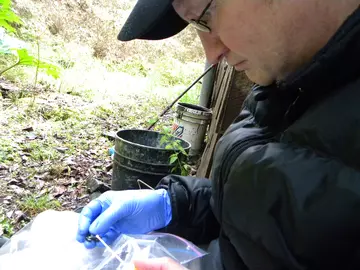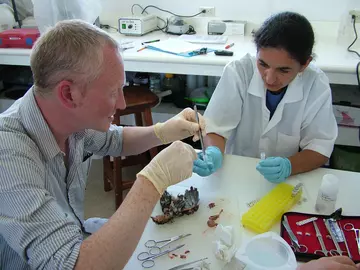
Wildlife epidemiology
One Health
Disease ecology
Institute of Zoology,
Zoological Society of London,
London,
NW1 4RY.
Andrew Cunningham is the Professor of Wildlife Epidemiology & Deputy Director of Science at the Institute of Zoology
Andrew's area of research aims to identify disease threats to wildlife conservation and how to prevent or mitigate these. This includes the mitigation of human-driven disease transmission (or spill-over) between species, including from wild animals to people.
Andrew works on wildlife health to reduce threats to wildlife conservation, to bring rare species threatened with disease back from the brink of extinction and to improve human-wildlife co-existence.

Andrew joined the Institute of Zoology in 1988 as Veterinary Pathologist for London Zoo and Whipsnade Zoo (1988-2001); a job which involved carrying out diagnostic pathology on zoo and wild animal species.
Since 2001, Andrew has developed a vibrant wildlife disease research group investigating infectious and non-infectious disease threats to wildlife conservation, including the drivers of disease emergence and zoonotic spill-over. In the 1990s, he discovered a new epidemic ranaviral disease of amphibians in Europe and published the first definitive report of the global extinction of a species by an infectious disease. Andrew has led, or co-led, several international and multi-disciplinary wildlife disease research projects, including the investigation of vulture declines in South Asia and the international research team that discovered the fungus Batrachochytrium dendrobatidis as a cause of amphibian declines (for which he was awarded a medal by the CSIRO in Australia).
In 2010, Andrew won a Royal Society Wolfson Research Merit Award for his work on zoonotic viruses in African bats and in 2016 he was elected a Fellow of the Royal College of Veterinary Surgeons for meritorious contributions to learning.

As a veterinary researcher, Andrew uses his skills and knowledge to identify and address disease threats to animal populations or entire species. Sometimes these threats can be mitigated, thus helping to stop species from becoming extinct. Sometimes the human drivers of disease are just too great to save a particular population or species, but in showing how this occurs, awareness is raised at the ground and policy levels, hopefully building capacity and resilience for future conservation efforts.

Current research
Andrew's current projects include investigating the emergence, spread, impact and mitigation of disease threats to wildlife conservation, understanding the role of anthropogenic environmental change on wildlife disease emergence and identifying factors which lead to zoonotic spill-over. Since his work on identifying ranaviral and chytrid fungal as pathogens threatening amphibians, much of his work is still focused on amphibian health and conservation. For example, amphibian taxa, he currently works to conserve include mountain chicken frogs (since 2002), Darwin’s frogs (since 2009) and Chinese giant salamanders (since 2010). Since 2007, he has worked with colleagues in Ghana and Cambridge University to understand the ecology of zoonotic pathogens infecting African bats and to identify risk factors for zoonotic spill-over.
Since the onset of the COVID-19 pandemic, Andrew has been increasingly involved in policy engagement to mainstream biodiversity conservation within the public health sector. For example, since its inception in 2021, he has been a member of the WHO/WOAH/FAO/UNEP One Health High Level Expert Panel which has an advisory role to the United Nations partner agencies on One Health-related matters to support improved cooperation among governments and provide evidence-based scientific and policy advice to address the challenges raised by One Health. Recently, he was an external advisor on One Health to the G7 and he provided advice to the G7-mandated One Health Intelligence Scoping Study and to PREZODE (Preventing Zoonotic Disease Emergence), an international initiative to better understand the risks of emergence of zoonotic infectious diseases, their prevention and their early detection.
Andrew is also a member of the Eklipse Expert Working Group on Biodiversity and Pandemics, and he is a member of the WHO Technical Advisory Group on One Health implementation in Europe.

- 2016–present Fellow, Royal College of Veterinary Surgeons
- 2015–present Deputy Director of Science, Institute of Zoology, Zoological Society of London
- 2013–present Visiting Professor, Universidad Andres Bello, Chile
- 2011–present Honorary Professor, University College London
- 2011–present Professor of Wildlife Epidemiology, Institute of Zoology, London
- 2010–2015 Royal Society Wolfson Research Merit Award
- 2007–2014 Deputy Head, Institute of Zoology, Zoological Society of London
- 2004–2010 Reader in Wildlife Epidemiology, Institute of Zoology, London
- 2001–present Head of Wildlife Epidemiology, Institute of Zoology, London
- 2001 PhD, University of London
- 1988–2001 Veterinary Pathologist, Institute of Zoology, London
- 1987–2016 Member, Royal College of Veterinary Surgeons
- 1987 BVMS, University of Glasgow
- BVMS, PhD, Dip ECZM (Wildlife Population Health), FRCVS
- EBVS® European Veterinary Specialist in Wildlife Population Health
Valenzuela-Sánchez, A., Azat, C., Cunningham, A. A., Delgado, S., Bacigalupe, L. D., Beltrand, J., Serrano, J. M., Sentenac, H., Haddow, N., Toledo, V., Schmidt, B. R. & Cayuela, H. (2022) Interpopulation differences in male reproductive effort drive the population dynamics of a host exposed to an emerging fungal pathogen. Journal of Animal Ecology 91, 308-319. https://doi.org/10.1111/1365-2656.13603
Jolma, E. R., Gibson, L., Suu-Ire, R. D., Fleischer, G., Asumah, S., Languon, S., Restif, O., Wood, J. L. N. & Cunningham, A. A. (2021) Longitudinal secretion of paramyxovirus RNA in the urine of straw-coloured fruit bats (Eidolon helvum). Viruses 13, 1654. https://doi.org/10.3390/v13081654.
Gibson, L., Ribas, M. P., Kemp, J., Restif, O., Suu-Ire, R. D., Wood, J. L. N. & Cunningham, A. A. (2021) Persistence of multiple paramyxoviruses in a closed captive colony of fruit bats (Eidolon helvum). Viruses 13, 1659. https://doi.org/10.3390/v13081659.
Crook, J. M., Murphy, I., Carter, D. P., Pullan, S. T., Carroll, M., Vipond, R., Cunningham, A. A.* & Bell, D. (2021) Metagenomic identification of a new sarbecovirus from horseshoe bats in Europe. Scientific Reports 11, 14723. https://doi.org/10.1038/s41598-021-94011-z
Valenzuela-Sánchez, A., Cayuela, H., Wilber, M., Canessa, S., Bacigalupe, L., Muths, E., Cunningham, A. A., Ozgul, A., Johnson, P. T. J. & Schmidt, B. R. (2021) Why disease ecology needs life-history theory: a host perspective. Ecology Letters 24, 876-890 https://doi.org/10.1111/ele.13681.
Redding, D. W., Atkinson, P. M., Cunningham, A. A., Lo Iacono, G., Moses, L. M., Wood, J. & Jones, K. E. (2019) Impacts of environmental and socio-economic factors on emergence and epidemic potential of Ebola in Africa. Nature Communications 10, 4531. https://doi.org/10.1038/s41467-019-12499-6
Dadam, D., Robinson, R. A., Clements, A., Peach, W. J., Bennett, M., Rowcliffe, M. J. & Cunningham, A. A. (2019) Avian malaria-mediated population decline of a widespread iconic bird species. Royal Society Open Science 6, 182197. https://doi.org/10.1098/rsos.182197
Yan, F., Lü, J., Zhang, B., Yuan, Z., Zhao, H., Huang, S., Wei, G., Mi, X., Zou, D., Xu, W., Chen, S., Wu, M., Xiao, H., Liang, Z., Tapley, B., Turvey, S. T., Papenfuss, T. J., Cunningham, A. A., Murphy, R. W., Zhang, Y. & Che, J. (2018) The Chinese giant salamander exemplifies the hidden extinction of cryptic species. Current Biology 28, R590-R592. https://doi.org/10.1016/j.cub.2018.04.004
O'Hanlon, S., Rieux, A., Farrer, R., Rosa, G. M., Waldman, B., Bataille, A., Kosch, T., Murray, K., Brankovics, B., Fumagalli, M., Martin, M. D., Wales, N., Alvarado-Rybak, M., Bates, K. A., Berger, L., Böll, S., Brookes, L., Clare, F., Courtois, E. A., Cunningham, A. A., Doherty-Bone, T. M., Ghosh, P., Gower, D., Hintz, W. E., Höglund, J., Jenkinson, T. S., Lin, C-F., Laurila, A., Loyau, A., Martel, A., Meurling, S., Miaud, C., Minting, P., Pasmans, F., Schmeller, D., Schmidt, B. R., Shelton, J. M. G., Skerratt, L. F., Smith, F., Soto-Azat, C., Spagnoletti, M., Tessa, G., Toledo, L. F., Valenzuela-Sánchez, A., Verster, R., Vörös, J., Webb, R. J., Wierzbicki, C., Wombwell, E., Zamudio, K. R., Aanensen, D. M., James, T. Y., Gilbert, M. T. P., Weldon, C., Bosch, J., Balloux, F., Garner, T. W. J. & Fisher, M. C. (2018) Recent Asian origin of chytrid fungi causing global amphibian declines. Science 360, 621-627. https://doi.org/10.1126/science.aar1965
Lawson, B., Robinson, R. A., Toms, M. P., Risely, K., MacDonald, S. & Cunningham, A. A. (2018) Health hazards to wild birds and risk factors associated with anthropogenic food provisioning. Philosophical Transactions of the Royal Society B 373, 20170091. https://doi.org/10.1098/rstb.2017.0091
Valenzuela-Sánchez, A., Schmidt, B. R., Uribe-Rivera, D., Costas, F., Cunningham, A. A.¶ & Soto-Azat, C.¶ (2017) Cryptic disease-induced mortality may cause host extinction in an apparently-stable host-parasite system. Proceedings of the Royal Society B: Biological Sciences 284: 20171176. http://dx.doi.org/10.1098/rspb.2017.1176
Cunningham, A. A., Daszak, P. and Wood, J. L. N. (2017) One Health, Emerging Infectious Diseases, and Wildlife: Two Decades of Progress? Philosophical Transactions of the Royal Society B. 372, 20160167. https://doi.org/10.1098/rstb.2016.0167
Lo Iacono, G., Cunningham, A. A., Fichet-Calvet, E., Garry, R. F., Grant, D. S., Leach, M., Moses, L. M., Nichols, G., Schieffelin, J. S., Shaffer, J. G., Webb, C. T. & Wood, J. L. N. (2016) A unified framework for the infection dynamics of zoonotic spillover and spread. PLoS Neglected Tropical Diseases 10, e0004957. https://doi.org/10.1371/journal.pntd.0004957
Hudson, M. A., Young, R. P., D’Urban Jackson, J., Orozco-terWengel, P., Martin, L., James, A., Sulton, M., Garcia, G., Griffiths, R. A., Thomas, R., Magin, C., Bruford, M. W. & Cunningham, A. A. (2016) Dynamics and genetics of a disease-driven species decline to near extinction: lessons for conservation. Scientific Reports 6, 30772. https://doi.org/10.1038/srep30772
Cunningham, A. A., Turvey, S. T., Zhou, F., Meredith, H., Guan, W., Liu, X., Sun, C., Wang, Z. & Wu, M. (2016) The development of the Chinese giant salamander (Andrias davidianus) farming industry in Shaanxi Province, China: conservation threats and opportunities. Oryx 50, 265-273. https://doi.org/10.1017/S0030605314000842
Jepson, P. D., Deaville, R., Barber, J. L., Aguilar, À., Borrell, A., Murphy, S., Barry, J., Brownlow, A., Barnett, J., Berrow, S., Cunningham, A. A., Davison, N., ten Doeschate, M., Esteban, R., Ferreira, M., Foote, A. D., Genov, T., Giménez, J., Loveridge, J., Llavona, Á., Martin, V., Maxwell, D. L., Papachlimitzou, A., Penrose, R., Perkins, M. W., Smith, B., de Stephanis, R., Tregenza, N., Verborgh, P., Fernandez, A. & Law, R. J. (2016) PCB pollution continues to impact populations of orcas and other dolphins in European waters. Scientific Reports 6, 18573. https://doi.org/10.1038/srep18573
Martel, A., Blooi, M., Adriaensen, C., Van Rooij, P., Beukema, W., Fisher, M. C., Farrer, R. A., Schmidt, B. R., Tobler, U., Goka, K., Lips, K. R., Muletz, C., Zamudio, K., Bosch, J., Lötters, S., Wombwell, E., Garner, T. W. J., Cunningham, A. A., Spitzen-van der Sluijs, A., Salvidio, S., Ducatelle, R., Nishikawa, K., Nguyen, T. T., Kolby, J., Van Bocxlaer, I., Bossuyt, F. & Pasmans, F. (2014) Recent introduction of a chytrid fungus endangers Western Palearctic salamanders. Science 346, 630-631. https://doi.org/10.1126/science.1258268
O’Shea, T. J., Cryan, P. M., Cunningham, A. A., Fooks, A. R., Hayman, D. T. S., Luis, A. D., Peel, A. J., Plowright, R. K. & Wood, J. L. N. (2014) Bat flight and emerging zoonotic viruses. Emerging Infectious Diseases 20. DOI: 10.3201/eid2005.130539.
Peel, A. J., Sargan, D. R., Baker, K. S., Hayman, D. T. S., Barr, J. A., Crameri, G., Suu-Ire, R., Broder, C. C., Wang, L-F., Fooks, A. R., Rossiter, S. J., Wood, J. L. N. & Cunningham, A. A. (2013) Continent-wide panmixia of an African fruit bat facilitates transmission of potentially zoonotic viruses. Nature Communications 4, 2770 https://doi.org/10.1038/ncomms3770
Luis, A. D., Hayman, D. T. S., O’Shea, T. J., Cryan, P. M., Gilbert, A. T, Pulliam, J. R. C., Mills, J. N., Willis, C. K. R., Timonin, M. E., Cunningham, A. A., Fooks, A. R., Rupprecht, C. E., Wood, J. L. N. & Webb, C. T. (2013) A comparison of bats and rodents as reservoirs of zoonotic viruses: Are bats special? Proceedings of the Royal Society, B. 280, 20122753. https://doi.org/10.1098/rspb.2012.2753
Wood, J. L. N., Leach, M., Waldman, L., MacGregor, H., Fooks, A. R., Jones, K., Restif, O., Dechmann, D., Hayman, D. T. S., Baker, K. S., Peel, A. J., Kamins, A. O., Fahr, J., Ntiamoa-Baidu, Y., Suu-Ire, R., Breiman, R. F., Epstein J. & Cunningham, A. A. (2012) A framework for the study of zoonotic disease emergence and its drivers: spillover of bat pathogens as a case study. Philosophical Transactions of the Royal Society, Series B. 367, 2881-2892. https://doi.org/10.1098/rstb.2012.0228
Farrer, R. A., Weinert, L. A., Bielby, J., Garner, T. W. J., Balloux, F., Clare, F., Bosch, J., Cunningham, A. A., Weldon, C., du Preez, L. H., Anderson, L., Pond, S. L. K., Shahar-Golan, R., Henk, D. A. & Fisher, M. C. (2011) Multiple emergences of amphibian chytridiomycosis include a globalised hypervirulent recombinant lineage. Proceedings of the National Academy of Sciences, USA 108,18732-18736. https://doi.org/10.1073/pnas.1111915108
Robinson, R. A., Lawson, B., Toms, M. P., Peck, K., Kirkwood, J. K., Chantrey, J., Clatworthy, I., Evans, A., Hughes, L., Hutchinson, O. C., John, S., Pennycott, T., Perkins, M., Rowley, P., Simpson, V. R., Tyler, K. & Cunningham, A. A. (2010) Emerging Infectious Disease leads to Rapid Population Decline of Common British Birds. PLoS ONE. 5(8), e12215. https://doi.org/10.1371/journal.pone.0012215
Kilpatrick, A. M., Daszak, P., Goodman, S. J., Rogg, H., Kramer, L. D., Cedeño, V. & Cunningham, A. A. (2006) Predicting pathogen introduction: West Nile virus spread to Galápagos. Conservation Biology 20, 1224-1231. https://doi.org/10.1111/j.1523-1739.2006.00423.x
Cunningham, A. A., Kirkwood, J. K., Dawson, M., Spencer, Y. I., Green, R. B. and Wells, G. A. H. (2004) Distribution of BSE infectivity in tissues of greater kudu (Tragelaphus strepsiceros). Emerging Infectious Diseases 10, 1044-1049. https://doi.org/10.3201/eid1006.030615
Jepson, P. D., Arbelo, M., Deaville, R., Patterson, T., Castro, P., Baker, J. R., Degollada, E., Ross, H. M., Herráez, P., Pocknell, A., Rodríguez, F., Howie, F., Espinosa, A., Reid, R. J.,Jaber, J. R., Martin, V., Cunningham, A. A. and Fernández, A. (2003) Gas-bubble disease in stranded cetaceans. Nature 425, 575-576. https://doi.org/10.1038/425575a
Cunningham, A. A., Daszak, P. and Rodríguez, J. P. (2003) Pathogen pollution: defining a parasitological threat to biodiversity conservation. Journal of Parasitology 89, S78-S83. https://www.researchgate.net/publication/284061023_Pathogen_pollution_Defining_a_parasitological_threat_to_biodiversity_conservation
Prakash, V., Pain, D. J., Cunningham, A. A., Donald, P. F., Prakash, N., Verma, A., Gargi, R., Sivakumar, S. and Rahmani,A. R. (2003) Catastrophic collapse of Indian white-backed Gyps bengalensis and long-billed Gyps indicus vulture populations. Biological Conservation 109, 381-390. https://doi.org/10.1016/S0006-3207(02)00164-7
Daszak, P., Cunningham, A. A. and Hyatt, A. D. (2000) Emerging Infectious Diseases of Wildlife: Threats to Biodiversity and Human Health. Science 287, 443-449. https://doi.org/10.1126/science.287.5452.443
Cunningham, A. A. and Daszak, P. (1998) Extinction of a species of land snail due to infection with a microsporidian parasite. Conservation Biology 12, 1139-1141. https://www.jstor.org/stable/2387588
Berger, L., Speare, R., Daszak, P., Greene, D. E., Cunningham, A. A., Goggin, C. L., Slocombe, R., Ragan, M. A., Hyatt, A. D., McDonald, K. R., Hines, H. B., Lips, K. R., Marantelli, G. and Parkes, H. (1998) Chytridiomycosis causes amphibian mortality associated with population declines in the rain forests of Australia and Central America. Proceedings of the National Academy of Sciences of the United States of America 95, 9031-9036. https://doi.org/10.1073/pnas.95.15.9031
Cunningham, A. A., Langton, T. E. S., Bennett, P. M., Lewin, J. F., Drury, S. E. N., Gough, R. E. and Macgregor, S. K. (1996) Pathological and microbiological findings from incidents of unusual mortality of the common frog (Rana temporaria). Philosophical Transactions of the Royal Society, London: Series B - Biological Sciences 351, 1539-1557. https://doi.org/10.1098/rstb.1996.0140
Kirkwood, J. K. and Cunningham, A. A. (1994) Epidemiological observations on spongiform encephalopathies in captive wild animals in the British Isles. Veterinary Record 135, 296-303. https://doi.org/10.1136/vr.135.13.296
- In May 2021, appointed one of 26 international experts to found the Quadripartite (WHO/FAO/OIE/UNEP) One Health High Level Expert Panel. The Panel has an advisory role to the United Nations partner agencies on One Health-related matters to support improved cooperation among governments and provide evidence-based scientific and policy advice to address the challenges raised by One Health.
- Keynote speaker at the 2021 AGM of the All Party Parliamentary Group on International Conservation.
- July 2021: participated in the Global Dialogue on the Role of Food and Agriculture in the Global Biodiversity Framework, convened virtually by the Convention on Biological Diversity (CBD) and the Food and Agriculture Organisation of the United Nations (FAO).
- September 2021: invited presentation given at a conference on Preventing Pandemics Through a More Plant-based Food System, convened in the Danish Parliament by the Vegetarian Society of Denmark. A video recording of this presentation can be found here.
- January 2022: as part of ZSL’s year-long collaboration with Expo2020, participated in the Health & Wellness week, giving a presentation on how zoonotic disease spill-over from wildlife happens followed by a discussion on pandemic prevention.
- Invited member of the Centre for European Policy Studies (CEPS) Expert Working Group on Alternative Configurations for the Institutional Design of the European Health Emergency preparedness and Response Authority (HERA), to advise on possible alternative configurations for future global and EU health governance.
- Invited by the Foreign, Commonwealth & Development Office to give a presentation, and participate in a panel discussion, on the Illegal Wildlife Trade and risks to Human Health as a contribution to a High-Level Conference of the Americas on Illegal Wildlife Trade, convened by the Government of Colombia and the Government of the United Kingdom in Colombia in April 2022.
- Provided advice to the G7-mandated One Health Intelligence Scoping Study and to PREZODE (Preventing ZOonotic Disease Emergence), an international initiative to better understand the risks of emergence of zoonotic infectious diseases, their prevention and their early detection.
